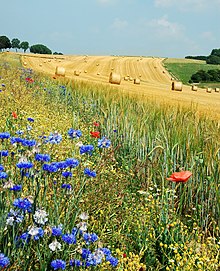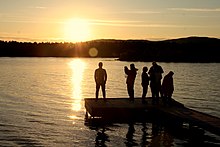Summer
The summer or summer is one of the four seasons of the temperate zones. It is the warmest of them. It follows spring and precedes autumn. Summer is characterized by longer days and shorter nights. Astronomically, the summer solstice (around December 21 in the south and June 21 in the boreal) marks the beginning of this season and the autumnal equinox (around March 21 in the south and September 23 in the boreal) marks the end of this season and the beginning of autumn.
In various cultures, the seasons begin on different dates, based on astronomical or meteorological phenomena. However, when summer occurs in the southern hemisphere it is winter in the northern hemisphere. As observed, summer can be boreal, when it occurs in the northern hemisphere, or austral, when it occurs in the southern hemisphere.
Summer is sometimes defined, however, as the entirety of December, January, and February in the southern hemisphere and as the entirety of June, July, and August in the northern hemisphere. In the intertropical zone the word "summer" is sometimes used to refer to the dry season, and "winter" to the rainy season. In the summer, activities such as going to the beach more often, camping in mountainous areas in the austral as it has the largest number of beaches and flora in the American continent are practiced.
Occurrence
From an astronomical point of view, the equinoxes and solstices would be the middle of the respective seasons, but sometimes the astronomical summer is defined as beginning on the solstice, the moment of maximum insolation, often identified with on June 21 or December. Instead, according to solar reckoning, summer begins on May Day, and the summer solstice is midsummer. A variable seasonal lag means that the weather center of the season, which is based on mean temperature patterns, occurs several weeks after the time of maximum insolation.
Meteorological convention is to define summer as comprising the months of June, July and August in the Northern Hemisphere and the months of December, January and February in the Southern Hemisphere. According to meteorological definitions, all seasons are arbitrarily set to begin at the beginning of a calendar month and end at the end of a month. This meteorological definition of summer also aligns with the commonly viewed notion of summer as the season with the longest (and warmest) days of the year., in which daylight predominates.
Meteorological station calculation is used in countries such as Australia, New Zealand, Austria, Denmark, Russia, and Japan. It is also used by many people in the UK and Canada. In Ireland, the summer months according to the national weather service, Met Éireann, are June, July and August. According to the Irish Calendar, summer begins on May 1 and ends on August 1. School textbooks in Ireland follow the cultural norm that summer begins on May 1 rather than the weather definition of June 1.
Days continue to lengthen from the equinox to the solstice, and summer days become progressively shorter after the solstice, so meteorological summer encompasses the accumulation of the longest day and a subsequent decrease, with summer having many more hours of daylight. light than spring Taking only daylight hours into account, the summer solstice marks the midpoint, not the beginning, of the seasons. The summer solstice takes place during the shortest night of the year, which is the summer solstice, or on a date close to it that varies according to tradition.
Where a seasonal offset of half a season or more is common, the calculation based on astronomical markers is shifted by half a season. Under this method, in North America, summer is the period from the summer solstice (usually June 20 or 21 in the Northern Hemisphere) to the autumnal equinox.
Including cultural holidays, the summer season in the United States is traditionally considered to begin on Memorial Day weekend (the last weekend in May) and end on Labor Day (the first Monday in September), which more closely fits the meteorological definition for parts of the country that have a four-season climate. The similar Canadian tradition begins the summer on Victoria Day a week earlier (although summer conditions vary greatly in the vast Canadian territory) and ends, as in the United States, on Labor Day.
In some countries in the southern hemisphere, such as Brazil, Argentina, South Africa, Australia and New Zealand, summer is associated with the Christmas and New Year holidays. Many families take extended vacations of two to three weeks or more during the summer.
In Chinese astronomy, summer begins around May 5, with the jiéqì (solar term) known as lìxià (立夏), meaning "establishment of summer", and ends around August 6.
In South and Southeast Asia, where the monsoon occurs, summer is more generally defined as the length of March, April, May, and June, the warmest time of the year, ending with the onset of the monsoon rains.[citation needed]
Because the temperature lag is shorter in the oceanic temperate southern hemisphere, most countries in this region use the meteorological definition with summer beginning on December 1 and ending on the last day of February.
Iconology
In the number of the four goddesses of the seasons existing in the town of Albaoi, Summer (synonymous with summer) is represented running with a lighted torch in each hand. In a tomb outside of Rome, where the Four Seasons were represented in stucco, Summer held a cloverleaf in one hand.
Among the paintings in Herculaneum, Italy, there is a figure dressed in yellow with a many-pronged hoe. On the funerary urn that represents the wedding of Thetis and Peleus, summer is represented more gallantly dressed (provided with a crown) than winter and autumn. He was also designated by the lion hunt. He was also painted in a yellow tunic, with a light blue mantle, a color that indicates the constant serenity of the sky during this season, especially in hot countries. Yellow indicates the maturity of the crops.
Moderns symbolize it as a young woman dressed in yellow crowned with spikes and carrying a burning torch. Others represent the almost naked summer, crowned with ears of wheat, holding in one hand the horn of plenty, overflowing with all kinds of grains and fruits, and in the other a sickle.
Time
Summer is traditionally associated with warm or temperate weather. In Mediterranean climates it is also associated with dry weather, while elsewhere (particularly in East Asia due to monsoons) it is associated with rainy weather. The wet season is the main period of vegetation growth within the savannah climate regime. When the wet season is associated with a seasonal change in prevailing winds, it is known as a monsoon.
In the North Atlantic Ocean, tropical cyclone season runs from June 1 to November 30. The statistical peak of the Atlantic hurricane season is September 10. The northeast Pacific Ocean has a longer period of activity, but in a similar time frame to the Atlantic. Tropical cyclones occur throughout the year in the northwest Pacific, with a minimum in February and March and a maximum in early September.. In the North Indian Basin, storms are most common from April to December, with peaks in May and November. In the Southern Hemisphere, tropical cyclone season runs from early November to late April, peaking in mid-April. February and early March.
Thunderstorm season in the United States and Canada runs from spring through summer, but can sometimes go as far as October or even November in the fall. These storms can produce hail, strong winds, and tornadoes, usually during the afternoon and evening.
Reference
- ↑ ASALE, RAE-. "summer". «Dictionary of the Spanish Language» - Edition of the Tricentennial. Retrieved July 14, 2019.
- ↑ Country, El (21 December 2018). "With the summer solstice the longest day arrives in the southern hemisphere." El País. ISSN 1134-6582. Retrieved July 14, 2019.
- ↑ "States of the Year." www.entrerios.gov.ar. Retrieved July 14, 2019.
- ↑ Ball, Sir Robert S (1900). id=sNSHRDu98k0C strangerpg=PA52 Elements of Astronomy. London: The MacMillan Company. p. 52. ISBN 978-1-4400-5323-8.
- ↑ Heck, Andre (2006). google.com/books?id=YSsaxkeixH0C fakepg=PA14 Organizations and strategies in Astronomy 7. Springer. p. 14. ISBN 978-1-4020-5300-9.
- ↑ Cecil Adams (11 March 1983). "Is it true that summer in Ireland begins on May 1st?" The Straight Dope. Archived from the original on August 30, 2011. Consultation on 27 September 2011.
- ↑ a b Meteorological Glossary. London: HMSO. 1991. p. 260. ISBN 978-0-11-400363-0."Professor Paul Hardaker answers questions on meteorological forecasting." Royal Geographical Society.
- ↑ Driscol, D. M.; Rice, P. B.; Fong, J. M. Y. (1994). org/record/1229243 «Space of the climate aspects of temperature: Interdiurn variable and delay». International Journal of Climatology 14 (9): 1001. Bibcode:1994IJCli..14.1001D. doi:10.1002/joc.3370140905.
- ↑ "The first day of the summer is worth celebrating." JSOnline. Archived from the original on 13 July 2011. Consultation on 27 September 2011.
- ↑ "The day of the father is the first day of the summer." Fox11online.com. 19 June 2009. Archived from the original on 17 September 2011. Consultation on 27 September 2011.
- ↑ "Summer solstice." The World of the Astronomy of Eric Weisstein. Scienceworld.wolfram.com. Consultation on 27 September 2011.
- ↑ Gabler, Robert E.; Petersen, James F.; Trapasso, L. Michael; Sack, Dorothy (2008). Physical Geography. Belmont, California: Cengage Learning. p. 107. ISBN 0495555061.
- ↑ Williams, Jack (February 22, 2005). «Responses: When the stations begin». Usatoday.Com. Archived from the original on January 27, 2012. Consultation on 27 September 2011.
- ↑ "Bureau of Meteorology". Bom.gov.au. 11 March 2011. Archived from the original on 12 September 2017. Consultation on 27 September 2011.
- ↑ Universal dictionary of mythology.
- ↑ Charles Darwin University (2009). Features of tropical savannahs. Archived on 17 February 2009 at Wayback Machine. Charles Darwin University. Retrieved on 27 December 2008.
- ↑ Glossary of Meteorology (2009). Monzón. Archived on 22 March 2008 at Wayback Machine. American Society of Meteorology. Retrieved 16 January 2009.
- ↑ a bc Atlantic Oceanographic and Meteorological Laboratory, Hurricane Research Division. «Frequently asked: When is the hurricane season?». National Oceanic and Atmospheric Administration. Archived from the original on 18 July 2006. Consultation on 25 July 2014.
- ↑ McAdie, Colin (10 May 2007). "Climatology of the Tropical Cyclones". National Hurricane Center. Archived from shtml the original on May 6, 2010. Consultation on 9 June 2007.
- ↑ "Tropical Cyclones Operational Plan for the Southeast of the Indian Ocean and the South Pacific". World Meteorological Organization. 10 March 2009. Archived from pdf the original on March 25, 2009. Consultation on 6 May 2009.
Contenido relacionado
Space Shuttle Columbia
Nebula
Jupiter (planet)




